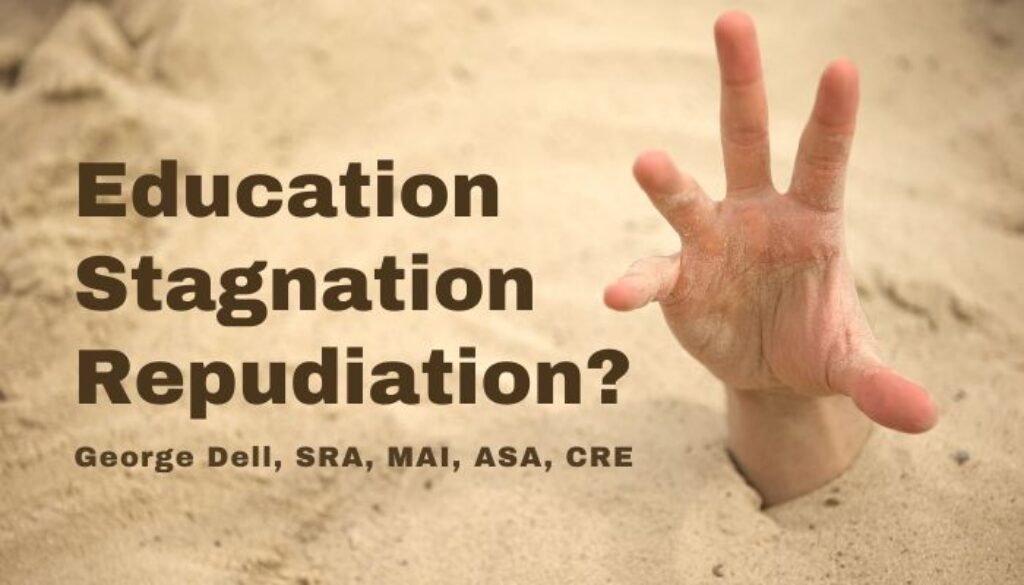Appraiser education is about a proven and “well-established” process! Developed nearly 100 years ago! The idea is to balance demand on supply, then explain where the subject fits.
1930s: Find some comps, compare, conclude.
2000s: Pick some comps, adjust to fit, conclude.
Yesterday: Pick good comps, adjust, adjust, conclude.
The embedded old ways obstruct modern methods – and any real benefit to the public trust (accuracy and reliability). Education is one of the “five frictions” of obstruction. So long as education enforces obsolete (but required) appraisal processes, issues of bias, subjectivity, and poor accuracy still remain.
Happily, today’s objective approach, (data science) brings simplicity, with today’s technology and data:
- Identify the Competing Market Segment (CMS)©;
- Apply one of the three predictive models;
- Provide a reliability/risk measure;
- Deliver data stream results.
So why does our educational structure (and content) remain the same? Why?
There are several related causes. But one stands out. The number 54. Fifty-four is the number of separate and unique state/territorial sets of appraiser curriculum regulators. Each state approves education (along with licensing). Each state has different methods of “approvals” necessary for learning.
Ironically, even as education content is identical everywhere – per the Appraisal Subcommittee (ASC) and Appraisal Foundation (AF) requirements – each class must be “approved” separately by each state. Alternatively, many states will approve on “pre-approved” AF approvals. The fee for AF approval is in the $ thousands, AND most states still want their forms and fees (in the $ hundreds) on top.
Each state must check off the same identical “qualifying education” (for licensing). And each state must approve per the same CE checklist of “approved’ topics.” Three problems: 1) providers’ costs; 2) inconsistent/divergent paperwork; and 3) content lethargy.
This blog considers problem #1, “approval” costs of education providers, and how it retards innovation.
These “approval” compliance costs include the fees, and the staff salaries. (Often separate forms for each course, for the “school,” and for each instructor.) Every state has different forms for each! (All together well over 100 totally separate distinct forms.)
You would think providers should be distinguished by new and useful offerings. You would think a system should reward progressive, tech-innovative methods. Not the case.
Education providers keep costs low by repeating, regurgitating old material, old Power Point slides, taught by old teachers entrenched in good teaching … in the old ways.
New ways of using new technologies require effort. And an investment of time and administration and especially paying fees to state regulators. 54 of them, plus the AF.
Innovation is stymied by the cost of development, trial runs, student resistance, state fees, and the overwhelming cost of administrating state applications, most requiring renewal and bi-annual fees.
Better to just re-sell and recycle the same ‘ol, same ‘ol. Sell CE hours, easy hours. No need to consider the public trust. Sell what’s easy to sell: CE hours, quickly and cheaply.
We need a unified, consistent, bias-disabling, education and enforcement system.

March 20, 2024 @ 7:48 am
Thank you for this first lesson in how the Federal Education System works. Bureaucracy at its finest.
March 20, 2024 @ 9:42 am
What is the cost of the new seminar and what is the cancellation policy?
March 26, 2024 @ 7:40 am
You’ve raised two issues here, and are 100% right on both. The duplicative approvals are a waste and a disgrace. If the Appraisal Foundation cared a bit about appraisers, they would have taken over this function years ago on a national basis. There is simply no value added for a Kansas bureaucrat to review and approve a course that’s already been reviewed and approved in Illinois. It’s just make-work, like digging a hole and filling it back in. Another problem, and I don’t know if this is nationwide or just in Washington, is the refusal to allow a course to count as both appraisal and brokerage education.
The second problem is the obsolete methods taught in appraisal. The action in applied economics since the 1980s has been in game theory, asymmetric information, and behavioral economics. None of this has penetrated the appraisal curriculum. Instead, appraisal education focuses on methods that are neither used by buyers or sellers, nor validated in real world results, like adjustment grids and analysis of depreciation. What buyer has ever tried to value “functional obsolescence – superadequacy”?